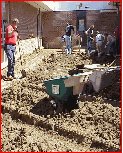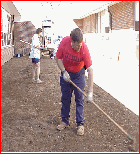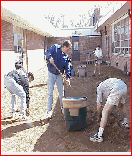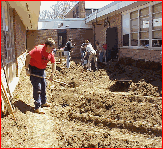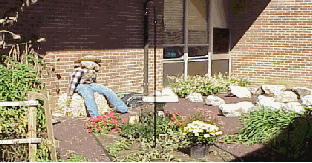|
The nurseries supplied marigolds, impatiens, snapdragons and ornamental ribbon grass either for free or at a reduced price.
Home Depot gave the school project other supplies, such as irrigation equipment, two arched trellises and hand cultivators as well as a lining material.
"I must have been somewhat persuasive;
plus they are a do-it-yourself type of corporation
so they understand that type of customer" Falik said.
The OBEF and the PTA helped the effort by
giving the school $500 each, said the teacher.
In addition, Principal Dr. Carl Schavio, who
was supportive from the beginning, gave extra inspiration when the task started to seem too big, said Falik, by telling her it did not have to be done all at once, but could be completed eventually in
phases.
For two weekends in April and May, parents and staff volunteered to till the soil, put down sand, gravel, weed deterrent fabric, pavers, and more than 20 tons of small stones.
"The parents and the community have really been supportive and done a lot of labor intensive
work," Falik said.
The investment made in sweat by the volunteers has already begun to pay off, according to
school educators.
This week for example as the rain fell on Monday some students sat with their noses pressed against the windows worried that the heavy rains would ruin their new gardens, Falik said.
Other children who have already planted their one allotted flower in the garden are asking to go back and plant again, she said.
"Children like being close to the earth," Falik said.
The area is also a peaceful sanctuary where students can pursue other educational and enjoyable activities. For instance, enough large rocks for each student have been put in the courtyard for them to sit on when they are reading or relaxing, she added.
"Not only is it a garden but every curricular subject could be taught out there. You could sketch a flower in the garden or you could have a math lesson by learning to measure it's perimeter."
Each of the more than 300 students has had the opportunity to plant a flower in the courtyard, which now consist of mostly annuals, a few perennial flowers and a few vegetables, Falik said.
|
|



